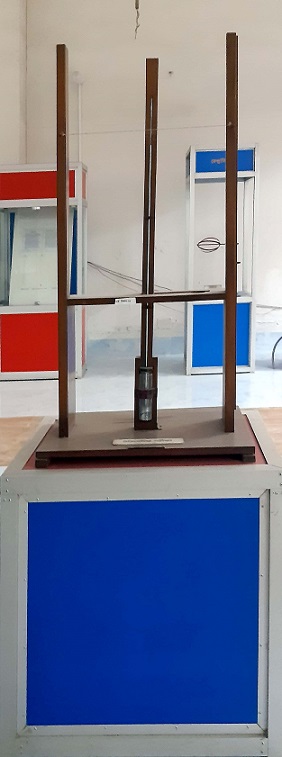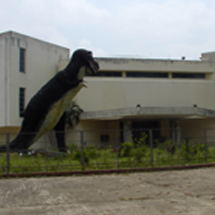টরিসেলির পরীক্ষা
এই প্রদর্শনীবস্তুটি বায়ু মন্ডলীয় চাপের অস্তিত্ব এবং এই চাপকে কিভাবে পরিমাপ করা যায় তাহা প্রদর্শন করে। ১৬৪৪ সালের ১১ জুনে ইভান্জলেলিস্তা টরিসেলি (১৬০৮ - ১৬৪৭) একটি পত্রে তাঁর প্রাপক, মাইকেল এঞ্জেলো রিচ্চিকে পরবর্তী পরীক্ষণটি সম্পর্কে লিখেছিলেন। টরিসেলি দুই ব্রাছিয়া (সি. ১১৫ সে.মি.) উচ্চতা বিশিষ্ট একটি কাচনল নিয়েছিলেন যা পারদে পরিপুর্ণ ও এক মুখ খোলা। তিনি নলটিকে উলটা করে দিলেন। খোলামুখ তাঁর আঙ্গুলের মাধ্যমে বন্ধ রেখে, খোলা মুখ নিচের দিকে রেখে সুষম প্রস্থচ্ছেদের নলটি একটি পারদপূর্ণ গামলায় খাড়াভাবে স্থাপন করেন। যখন খোলা মুখ থেকে তাঁর আঙ্গুলটি বের করে নিয়ে এলেন, তিনি প্রত্যক্ষ করেন যে পারদেরর কলামটি নিচে নামে, ১ ১/৪ ব্রাছিয়া (সি. ৭৬ সে.মি.) উচ্চতায় থেমে যায়। একটি প্রমাণ হিসেবে টরিসেলি ঘটনাটি পর্যবেক্ষণ করলেন যে গামলাস্থিত পারদের পৃষ্ঠতলের উপর বায়ুমন্ডলীয় চাপ হতে উদ্ভুত প্রতিরোধ দ্বারা পারদ কলামের অবনমন বন্ধ হয়। তিনি পর্যবেক্ষণ করেন যে কলামের উচ্চতা তাপমাত্রার পরিবর্তনে পরিবর্তিত হয়। তিনি আরও অনুমান করেন যে পারদ অবনমনের পর নলটির বদ্ধ প্রান্তে একটি শূন্যস্থান থাকে। শূণ্যস্থানের অনস্তিত্ত্বের প্রচারকারী ও এরিষ্টাটলের প্রথাগত শিক্ষণ অনুসারীদের মধ্যে এই দাবী দীর্ঘ ও উত্তপ্ত বিতর্ক সৃষ্টি করে, যা শূণ্যস্থানের সম্ভাবনাকে অস্বীকার করে। কাচ নলে পারদ স্তম্ভের উপরে খালি জায়গা টরিসেলীয় শূণ্যস্থান নামে পরিচিত। স্থানটি সম্পূর্ণভাবে ফাঁকা নয়। সেখানে অবশ্যই পারদের সুসিক্ত বাষ্প থাকে। কক্ষ তাপমাত্রায় পারদের সুসিক্ত বাষ্পের চাপ নগণ্য। সুতরাং টরিসেলীয় শূণ্যস্থান নামে এই স্থানের নামকরণ অত্যন্ত যুক্তিসঙ্গত। তাহলে পাত্রটির পারদের উপরে পারদ স্তরের উচ্চতা (h) হলো বায়ুমণ্ডলীয় চাপ পরিমাপ। যদি পারদের ঘনত্বr এবং ঐ জায়গার মহাকর্ষীয় ত্বরণ g হলে বায়ুমন্ডলীয় চাপ হবে h r g ।

This exhibit demonstrates the existence of atmospheric pressure and how the exerted pressure can be measured. In a letter of June 11, 1644, Evangelista Torricelli (1608-1647) reported the following experiment to his correspondent, Michelangelo Ricci (1619-1682). Torricelli took a glass tube two braccia (c. 115 cm) in height, open at one end, and filled it with mercury. He then turned the tube upside down. Keeping the open end closed with his finger, he placed the tube of uniform cross-section upright in a bowl full of mercury, with the open end facing down. When he removed his finger from the opening, he observed that the mercury column descended, stopping at a height of 1 1/4 braccia (c. 76cm). Torricelli saw this phenomenon as evidence that the descent of the mercury column was blocked by resistance from the atmospheric pressure on the surface of the mercury in the bowl. He observed that the height of the column varied with temperature changes. He also assumed that a vacuum remained in the closed end of the tube after the descent of the mercury. This claim sparked a long and heated dispute between those who proclaimed the existence of the void and those who followed traditional Aristotelian teaching, which denied the possibility of the vacuum. The space above the mercury level in the glass tube is known as Torricellian vacuum. This space is not perfectly empty. There must exist saturated vapour of mercury. The saturated vapour pressure of mercury at room temperature is negligible. So why naming of this space as Torricellian vacuum is quite reasonable. Then the height (h) of mercury level above the mercury of the pot is the measure of atmospheric pressure. If the density of mercury is r and gravitational acceleration of the place is g, then the atmospheric pressure will be hrg.


.jpg)















